Abstract
The occurrence of fires in tropical peatlands poses significant threats to their ecosystems. An Internet of Things (IoT) system was developed to measure and collect fire risk factors in the Raja Musa Forest Reserve (RMFR) in Selangor, Malaysia, to address this issue. In this paper, neural networks with different layers were employed to predict peatland forests’ Fire Weather Index (FWI). The neural network models used two sets of input parameters, consisting of four and nine fire factors. The predicted FWI values were compared with actual values obtained from the Malaysian meteorological department. The findings revealed that the five-layer neural network outperformed others in both the four-input and nine-input models. Specifically, the nine-input neural network achieved a mean square error (MSE) of 1.116 and a correlation of 0.890, surpassing the performance of the four-input neural network with the MSE of 1.537 and the correlation of 0.852. These results hold significant research and practical implications for precise peatland fire prevention, control, and the formulation of preventive measures.
1. Introduction
Peatland forest resources are one of the most critical resources on Earth. They can regulate the climate; maintain water and soil; mitigate or prevent natural disasters such as drought, flood, sandstorm, and hail; and are an essential basis for ensuring sustainable human development [1]. A fire will destroy the balance of the peatland forest ecosystem. It is difficult to recover the forest ecosystem after a fire, especially because a high intensity and large area forest fire will cause devastating damage to the entire forest ecosystem [2]. Therefore, realizing the timely, rapid, accurate, and effective prediction and suppression of forest fires is the key to eliminating the hidden danger of forest fires.
Forest fires pose a significant threat to ecosystems and human lives worldwide. In Malaysia, peatlands, which are carbon-rich ecosystems, are particularly vulnerable to fire outbreaks due to their unique characteristics [3]. The occurrence and severity of forest fires in Malaysia’s peatlands have been on the rise in recent years, resulting in substantial environmental damage and economic losses [4]. To mitigate the impact of these fires, accurate prediction and early detection systems are crucial.
However, the peatland forest fire is a natural disaster with strong suddenness, wide occurrence, and significant harm, which can seriously damage the forest ecosystem [5]. A natural disaster refers to an extreme event or phenomenon that occurs in nature and causes significant damage or loss of life and property [6]. Peatland forest fires meet this definition because they can harm the environment, biodiversity, human lives, and property. The rapid spread and intensity of forest fires can lead to the loss of valuable vegetation, the destruction of habitats, the release of greenhouse gases, and the disruption of ecosystem services [7]. Currently, large-scale forest fires have been listed by the United Nations as one of the eight natural disasters in the world [8]. For forest fire control, prevention is more effective than fighting [9]. Forest fire prediction has always been the focus of relevant scientific researchers and forest fire prevention workers. In addition, due to the particularity of rainy weather in tropical areas, it is necessary to take the groundwater level caused by rainfall into account to predict peatland forest fires in tropical areas [10]. Therefore, it is of great research value and practical significance to carry out the risk prediction of peatland forest fires in tropical areas and carry out accurate prevention and control accordingly.
Peatlands represent unique ecosystems with specific fire dynamics [11], posing challenges for traditional fire prediction methods. Existing approaches often face limitations in capturing the complex relationships between atmospheric variables and fire occurrences in these environments [12]. Hence, the need arises for novel techniques that can overcome these challenges and improve prediction accuracy. In this paper, we propose the utilization of machine learning, specifically neural network models, to address the shortcomings of conventional methods. By leveraging the inherent capacity of neural networks to learn complex patterns from data [13], our approach aims to enhance the predictive capabilities for forest fire occurrence in peatland areas. The justification for employing machine learning techniques in this context is supported by prior studies [14,15] demonstrating their efficacy in capturing intricate relationships and achieving improved predictive performance in various domains.
Machine learning techniques have shown great potential in various domains, including environmental modeling and prediction. Leveraging the power of machine learning algorithms, this paper aims to develop a robust predictive model for forest fire occurrences in Malaysia’s peatlands. By harnessing the vast amount of available data on weather conditions and land cover, this research contributes to the advancement of fire prediction and prevention strategies in peatland areas. The outcomes of this research have significant implications for fire management and prevention strategies in Malaysia’s peatlands. Accurate fire prediction models can facilitate early warning systems, enabling authorities to allocate resources effectively and implement preventive measures to minimize the impact of forest fires. The main contributions of this paper are as follows:
- The neural network models are proposed for predicting the Fire Weather Index (FWI) in peatland areas, utilizing both a four-input and a nine-input configuration. These neural network models leverage atmospheric temperature, atmospheric humidity, wind speed, rainfall, groundwater level, soil temperature, soil humidity, atmospheric pressure, and solar radiation, all measured by the peatland IoT monitoring system.
- The feasibility of peatland fire prediction based on a neural network is verified by comparing the predicted Fire Weather Index (FWI) with the actual value published by the Malaysian meteorological department.
- The collection and compilation of a comprehensive dataset that includes historical FWI values, weather conditions, and other relevant environmental variables specific to peatland areas in Malaysia. This dataset serves as a valuable resource for training and evaluating the neural network models, thus contributing to the advancement of research in this domain.
By integrating these environmental variables into the neural network models, we aim to capture the complex relationships and interactions between weather conditions and the FWI. The four-input neural network model provides a concise representation of the atmospheric factors, while the nine-input model incorporates a more comprehensive set of environmental variables, enabling a more holistic understanding of fire risks in peatland areas. These proposed models take advantage of real-time data collected through IoT-based monitoring systems, allowing for timely and accurate predictions of the FWI. By harnessing the power of machine learning, these models can provide valuable insights for fire management and prevention strategies, facilitating early detection, resource allocation, and proactive measures to mitigate the impact of forest fires.
The comparative analysis between the two neural network models allows for a deeper understanding of the influence of additional environmental variables on fire risk predictions. This comparative evaluation provides insights into the performance and effectiveness of the different input configurations, aiding in the identification of key factors and their impact on FWI predictions in peatland areas. The proposed neural network models serve as valuable tools for fire risk assessment and management in Malaysia’s peatlands, contributing to the advancement of predictive capabilities and facilitating proactive measures to protect these vital ecosystems and surrounding communities.
2. Materials and Methods
This section introduces the peatland data monitored by the IoT system and the relevant parameters of the neural network used to predict peatland fires in Malaysia.
2.1. Data Preparation
The meteorological data in this paper are all from the monitoring of the peatland IoT system deployed in the Raja Musa Forest Reserve (RMFR), Selangor, Malaysia, as shown in Figure 1.
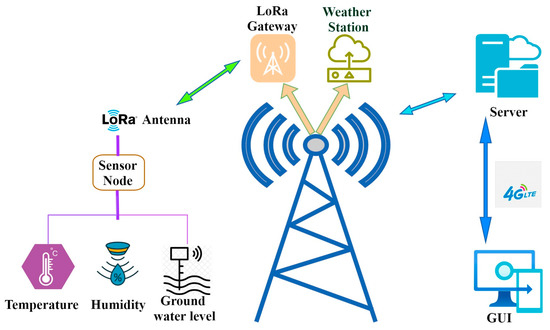
Figure 1.
Peatland IoT system architecture.
The Raja Musa Forest Reserve (RMFR), located in Selangor, Malaysia, is the focal point of our research on peatland forest fire prediction using machine learning techniques. The RMFR is a significant peatland ecosystem encompassing a vast area of pristine tropical forest [16]. The RMFR exhibits diverse vegetation compositions, covering an extensive land area, including peat swamp forests characterized by the prevalence of peat soil layers and unique plant adaptations [17]. The reserve’s topography features undulating terrain interspersed with water bodies and intricate drainage patterns typical of peatland ecosystems. In terms of climate, the RMFR experiences a tropical rainforest climate with relatively high humidity and abundant rainfall throughout the year [18]. These climatic conditions, coupled with the presence of peat soils, contribute to the elevated risk of forest fires within the reserve. By conducting our research within the unique ecological setting of the Raja Musa Forest Reserve, this paper aims to contribute to understanding peatland forest fire dynamics and enhance the effectiveness of fire prediction and prevention strategies in similar ecosystems globally.
Figure 1 shows the architecture of the IoT system, which was deployed at RMFR, Kuala Selangor, Malaysia, with the north latitude of 3°27′58″ and the east longitude of 101°26′31″. The IoT system mainly comprises sensor nodes, including humidity, temperature, and water level sensors and LoRa antennas, which transmit the monitored peatland soil parameter data to the LoRa gateway located in the observation tower. Furthermore, the weather station is also located in the observation tower. Finally, LoRa transmission technology and LTE cellular network transmission display the peatland forest data monitored by the IoT system on a GUI page. Moreover, it was put into use on 17 January 2020. More information based on the IoT system has been described in detail in our team’s previous publication [19,20,21]. The histogram of the data used in this paper is shown in Figure 2.
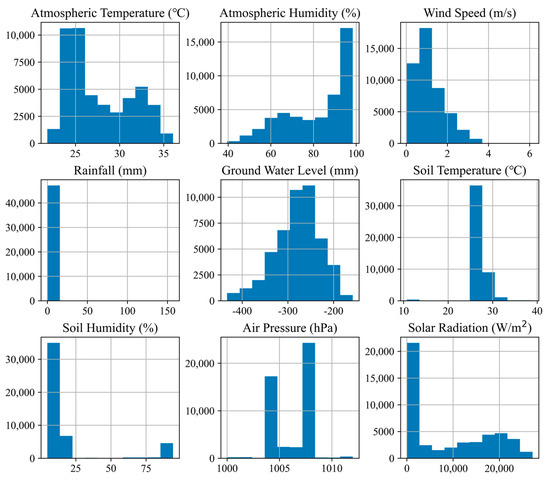
Figure 2.
Peatland data measured by IoT system from ground and weather sensors.
The Internet of Things (IoT) monitoring system deployed in the Raja Musa Forest Reserve (RMFR) encompasses a wide coverage area, extending throughout the entire reserve. Within this system, sensors are strategically placed to enable real-time data monitoring at a frequency of once per minute. The collected data are transmitted wirelessly through LoRa antennas located on the sensor nodes to the LoRa gateway. Subsequently, the data are transmitted via the LTE cellular network to a central server for storage and analysis. A custom-developed dashboard allows for visualization and analysis of the collected data. To ensure the integrity and reliability of the data, measures have been implemented to protect the sensor nodes from external interferences, such as wildlife disturbances, by enclosing them within a one-meter-high protective iron fence.
Figure 2 shows the distribution of the meteorological parameter data of fire risk factors monitored by the IoT system. It is composed of nine sub-distribution maps of meteorological parameters in three rows and three columns, including atmospheric temperature, atmospheric humidity, wind speed, rainfall, groundwater level, soil temperature, soil humidity, air pressure, and solar radiation. Each subgraph’s abscissa represents the parameter’s value, while the ordinate represents the number of values. In addition, the number of samples for the nine meteorological parameters is the same, namely 47,306 samples.
2.2. Neural Network for Predicting FWI
This paper uses a multi-layer neural network to predict the Fire Weather Index (FWI) of peatland forests. The neural network has strong self-learning, self-organizing, and adaptive capabilities [22]. It has obvious advantages in processing fuzzy, random, and linear data [23], especially for systems with large-scale, complex structures and unclear information [24]. In a multi-layer neural network, each layer contains several neurons. Through repeated learning and training of the available information, the method of gradually adjusting and changing the connection weight between each neuron is used to process the relationship between information and analogue input and output [25]. It does not need to know the exact relationship between input and output to obtain an accurate prediction value [26].
In the Canadian Fire Weather Index (FWI) system proposed by Van Wagner [27] in 1987, the FWI is determined by four meteorological parameters: atmospheric temperature, humidity, wind speed, and rainfall. According to the four meteorological parameters of the Canadian Fire Weather Index model, a four-input N-layer neural network for predicting the FWI is proposed in this paper, as shown in Figure 3.
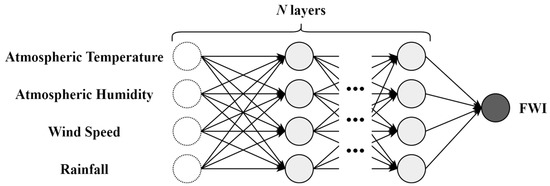
Figure 3.
Four-input, N-layer neural network for predicting the FWI.
Figure 3 shows four basic meteorological parameters based on atmospheric temperature, humidity, wind speed, and rainfall as the input quantities. Then, each input neuron in the input layer is transferred to the hidden layer through adaptive linear learning. The hidden layer completes the final regression learning to match the corresponding output layer result of the Fire Weather Index (FWI), which is used to assess the possibility of fires in the peatland and provide correct guidance for fire prevention.
Multi-layer neural networks are composed of layers of interconnected nodes called neurons. Each neuron in the input layer corresponds to one input feature, in this case, temperature, humidity, wind speed, and rainfall. The values of these input features are fed into the network, and they are multiplied by weights and passed through an activation function. The hidden layer neurons receive the weighted inputs from the input layer and apply an activation function to produce an output. The weights and activation functions of the neurons in the hidden layer are learned through a training process, typically using gradient descent optimization algorithms such as backpropagation. The purpose of the hidden layer is to capture complex patterns and relationships between the input features.
Finally, the output neuron takes the weighted outputs from the hidden layer and applies an activation function to produce a single output value, which is the predicted FWI (Fire Weather Index) in this case. The activation function used for the output neuron might depend on the nature of the prediction task, such as a linear activation function for regression or a sigmoid activation function for binary classification. During the training phase, the neural network adjusts the weights based on the error between the predicted FWI and the actual FWI from the training data. The training process iterates over multiple epochs, continually updating the weights to minimize the error. Once the training is completed, the neural network can be used to predict FWI values for new input data.
However, for the prediction of peatland fires in tropical areas, soil parameters need to be considered, namely, groundwater level [28], soil temperature [29], soil humidity [30], etc. In addition, according to the actual theoretical situation, atmospheric pressure and solar radiation should also be considered factors in predicting peatland fires [31]. Therefore, in this paper, a multi-layer neural network considering nine potential factors leading to peatland fires is proposed to predict the occurrence of peatland fires, as shown in Figure 4.
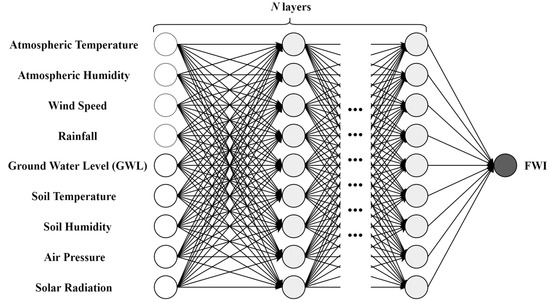
Figure 4.
Nine-input, N-layer neural network for predicting FWI.
Figure 4 shows a multi-layer neural network structure with nine-input parameters for predicting peatland fires in Malaysia. It is formed by adding five additional potential factors affecting the occurrence of fire based on the neural network structure shown in Figure 3. While the existing Fire Weather Index (FWI) model calculates fire risk based on meteorological parameters such as temperature, humidity, rainfall, and wind speed, it is indeed beneficial to consider additional parameters for a more comprehensive assessment of fire risk in peatlands. In addition to the existing meteorological parameters, incorporating the following factors—solar radiation, soil temperature, soil humidity, pressure, and groundwater level—can provide valuable insights into fire risk assessments in peatlands:
- Solar Radiation: Solar radiation represents the amount of energy received from the sun and influences the drying potential of vegetation and fuel moisture content. Higher solar radiation levels contribute to increased evaporation rates and can accelerate the drying of peatland vegetation. Including solar radiation data in the fire risk assessment helps capture the impact of sunlight on fuel moisture and the overall flammability of the ecosystem.
- Soil Temperature: Soil temperature plays a crucial role in determining fuel moisture content and the ignition potential of peatlands. Elevated soil temperatures can lead to drier conditions and more favorable conditions for ignition and fire spread. By monitoring the soil temperature, the model can identify areas with higher thermal stress and increased fire susceptibility, providing early warning signs of potential fire outbreaks.
- Soil Humidity: Soil humidity, specifically moisture content in the upper layers of the soil, is a critical parameter for assessing fire risk. Dry soil conditions contribute to reduced moisture availability for vegetation, increasing the potential for fire ignition and spread. Including soil humidity data allows for a better understanding of local moisture conditions and their influence on fire behavior within the peatland ecosystem.
- Atmospheric Pressure: Atmospheric pressure affects weather patterns and airflow, which can impact fire behavior and fire spread. Changes in atmospheric pressure can influence wind patterns, the availability of oxygen for combustion, and the overall stability of the atmosphere. By considering atmospheric pressure as a parameter, the fire risk assessment model can capture the influence of pressure systems on fire dynamics and the potential for rapid fire development.
- Groundwater Level: Groundwater level is a critical parameter for understanding the moisture conditions in peatlands. High groundwater levels indicate a higher availability of water for fire suppression and can serve as a natural firebreak. Monitoring groundwater levels helps identify areas with a lower fire risk due to the presence of sufficient moisture. Additionally, changes in groundwater level can affect peatland hydrology and contribute to variations in fire behavior.
By considering the correlation between these factors and existing meteorological data, the model can provide a more accurate and holistic assessment of the fire risk. This paper compares the performance of neural network structures with different numbers of layers from 3 to 7 for peatland fire prediction.
2.3. Performance Evaluation
The Fire Weather Index (FWI) system is an important tool for assessing the risk of forest fires. However, the accuracy of the FWI system depends on various factors, such as the inputs used, the algorithm used, and the calibration of the system. Therefore, evaluating the performance of the FWI system is essential to ensure its reliability and effectiveness in predicting forest fire risk. In this paper, the performance evaluation of the FWI system will be performed by using machine learning techniques. Specifically, the performance of the FWI system will be evaluated by using the mean squared error (MSE), root mean squared error (RMSE), mean absolute error (MAE), and R-squared (or correlation or coefficient of determination) (R2) metrics. These metrics are commonly used in machine learning to evaluate the accuracy and precision of predictive models [10].
where is the number of samples in the dataset; is the i-th predicted value; is the mean of the actual values.
The MSE value is always positive, and a smaller value indicates a better fit between the predicted and actual values. However, the MSE has the disadvantage of being sensitive to outliers, as the squared differences amplify their effects on the overall error. The RMSE is a popular performance metric used in a regression analysis to measure the difference between predicted values and actual values. It is similar to the MSE but takes the square root of the average of the squared errors, making it more interpretable in the same unit as the target variable. The dimensions of the error indicators calculated by the RMSE and MAE are consistent with the target variable, but after obtaining the results, it will be found that the RMSE is slightly larger than the MAE. This is because the RMSE first accumulates the squared errors before the square root, which actually amplifies the difference between larger errors.
The coefficient of determination (R-squared or correlation), denoted as R2, is a statistical measure that represents the proportion of the variance in the dependent variable that is explained by the independent variables in a regression model. It ranges from 0 to 1, where a value of 1 indicates a perfect fit and 0 indicates no linear relationship between the dependent and independent variables. The formula for R2 is:
where is the number of samples in the dataset; is the i-th actual value; is the i-th predicted value; is the mean of the actual values.
In general, an R2 value of 0.8 or higher is considered to be a good fit for a regression model, indicating that 80% or more of the variance in the dependent variable can be explained by the independent variables.
3. Results and Discussion
In this section, the FWI published by the Malaysian meteorological department and 80% of the data measured by the IoT system in Section 2.1 are imported into the two neural network structures proposed in Section 2.2 for training (i.e., 37,844 samples). Then, the remaining 20% (i.e., 9462 samples) dataset is used to test the performance of the two structural training models. The performance is compared from four aspects: mean square error (MSE), root mean square error (RMSE), mean absolute error (MAE), and correlation (R2), as shown in Figure 5 and Figure 6.
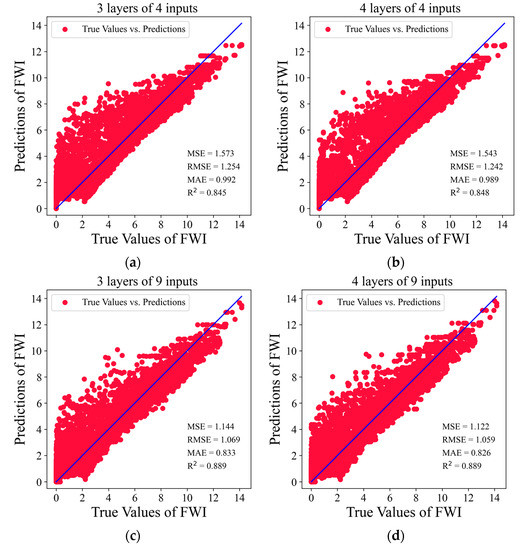
Figure 5.
Performance of different neural networks. (a). 3-layer 4-input, (b). 4-layer 4-input, (c). 3-layer 9-input, (d). 4-layer 9-input.
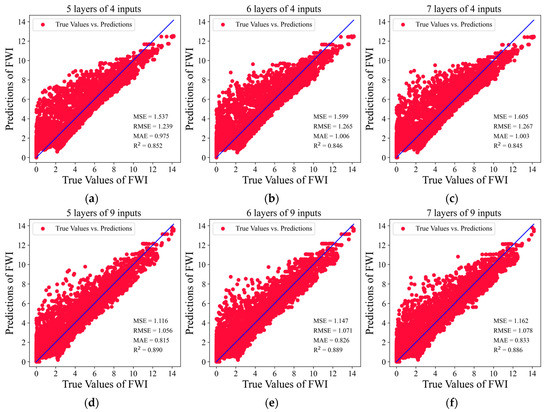
Figure 6.
Performance of different neural networks. (a). 5-layer 4-input, (b). 6-layer 4-input, (c). 7-layer 4-input, (d). 5-layer 9-input, (e). 6-layer 9-input, (f). 7-layer 9-input.
Figure 5 compares the FWI predicted value and the actual value obtained by machine learning based on the four-input and nine-input neural networks in three and four layers. The results show that the prediction structure of the four inputs and three layers in Figure 5a can reach the MSE of 1.573, the MAE of 0.992, the RMSE of 1.254, and the correlation of 0.845. The prediction structure of nine inputs and three layers in Figure 5c performs better and achieves the MSE of 1.144, the MAE of 0.833, the RMSE of 1.069, and the correlation of 0.889. The performance comparison of the peatland fire prediction based on four-layer (four-input and nine-input) neural networks is shown in Figure 5b,d. The overall performance of four inputs does not reach the nine-input neural network structure. Compared with the three-layer structure in Figure 5a,c, the prediction performance of the four-layer neural network could be better.
Figure 6 compares the fire prediction performance of peatland with different input layers of five-layer, six-layer, and seven-layer structures. The results show that the five-layer structure achieves the most accurate match between the predicted value and the actual value, which is not achieved by the other layers of the prediction structure. The results show that the prediction structure of four inputs and six layers has an MSE of 1.599, the MAE of 1.006, a correlation of 0.846, and an RMSE of 1.265. The nine-input prediction structure performs better and achieves the MSE of 1.147, the MAE of 0.826, the RMSE of 1.071, and the correlation of 0.886. As for seven-layer neural networks, the results show that compared with other layers of structure, the performance of layer seven is the worst, which signals that we will not continue to develop prediction models with more layers for machine learning. For limited datasets, blindly increasing the number of layers of the neural network will not only increase the processing complexity of machine learning and reduce the learning efficiency, but also reduce the accuracy due to the limited allocation of data resources due to the increase in layers.
From Table 1, the results show that increasing the number of layers from three to five generally improves the model’s performance, as indicated by the decreasing values of MSE, RMSE, and MAE and increasing values of R2. However, increasing the number of hidden layers from six to seven results in a slight decrease in performance, as evidenced by the slight increase in MSE and RMSE and the decrease in R2. This indicates that there may be a point of diminishing returns in adding more layers to the model beyond a certain threshold. In addition, increasing the number of layers beyond a certain threshold can also lead to overfitting. Therefore, it may be better to use a neural network model with a moderate number of hidden layers for the FWI prediction.

Table 1.
Performance comparison of four-input and nine-input neural networks with different numbers of layers for FWI prediction.
Moreover, the performance of the neural network model with six and seven layers is slightly worse than the model with five layers in terms of all evaluation metrics. This observation suggests that increasing the number of layers beyond a certain threshold may not always result in a better model performance. In fact, adding too many layers can lead to overfitting, where the model becomes too complex and starts to fit the noise in the data, resulting in poor generalization performance on new data. Therefore, it is important to carefully balance the number of layers and other neural network hyperparameters to achieve the best possible performance.
In order to more conveniently and intuitively compare the performance of the predicted structures with different layers, the four aspects of mean square error, root mean square error, mean absolute error, and correlation are selected to draw a histogram to compare the accuracy of the peatland fire prediction, as shown in Figure 7.
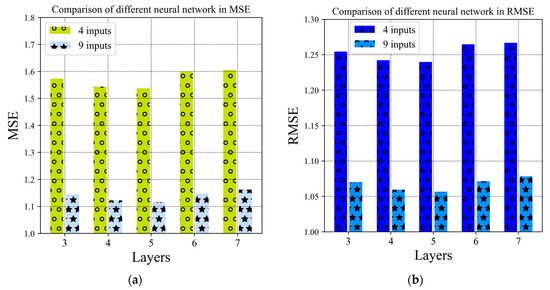
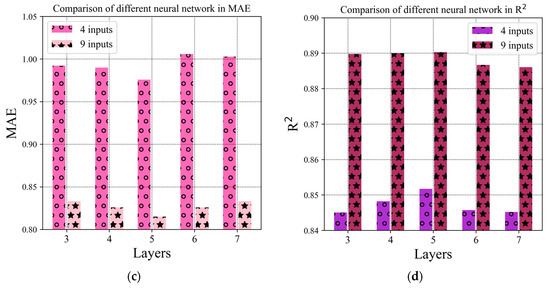
Figure 7.
Comparison of prediction performance of different neural networks (a). Performance in mean square error (MSE); (b). performance in root mean square error (RMSE); (c). performance in mean absolute error (MAE); (d). performance in correlation (R2).
Figure 7 compares the performance of different layers (ranging from three to seven layers) of two input modes (namely, four inputs and nine inputs) for predicting the FWI. The results indicate that the performance of predicting the Fire Weather Index (FWI) using neural networks is better with nine inputs compared to four inputs, regardless of the number of layers. The evaluation metrics, including mean squared error (MSE), root mean squared error (RMSE), mean absolute error (MAE), and R-squared (R2), consistently demonstrate the superiority of the nine-input models over the four-input models. Figure 7a shows that with the increase in the number of layers, the mean square error of the two input modes starts to decrease, and the lowest point reached by the five layers is 1.537 for the four inputs and 1.147 for the nine inputs. However, the mean square error of the structure starts to increase from the five layers to the seven layers, which is a manifestation of the lower prediction accuracy. The same performance trend occurs in the correlation of different layers shown in Figure 7d. At the five layers, four inputs and nine inputs reach the highest correlation, namely 0.846 for four inputs and 0.886 for nine inputs.
In summary, among the different configurations evaluated, the nine-input, five-layer neural network structure demonstrates the best performance for predicting the Fire Weather Index (FWI). This model exhibits superior accuracy and precision compared to other configurations with varying numbers of inputs and layers. These results suggest that the inclusion of nine-input features and the utilization of a five-layer neural network architecture provide the optimal balance between complexity and predictive performance for the FWI estimation. Researchers and practitioners can rely on the nine-input, five-layer model as a robust and reliable tool for FWI prediction in forest fire risk assessment and management.
Figure 8 compares the Fire Weather Index (FWI) predicted by a nine-input, five-layer neural network and the FWI published by METMalaysia between 17th January and 31st March 2020. The upper subplot displays the distribution of the FWI published by METMalaysia, while the lower subplot shows the FWI predicted by the neural network. The color bar in the middle of the figure represents the FWI risk level, with blue indicating low risk (0–2), green indicating moderate risk (2–7), yellow indicating high risk (7–13), and red indicating extreme risk (>13). Overall, the color zones in the upper and lower subplots are similar, except for some discrepancies on 25th and 27th January, where the predicted FWI shifted from green to yellow, and on 6th March, where a blue risk level was predicted as green. This suggests that the neural network can effectively predict the FWI levels and is in agreement with the published data.
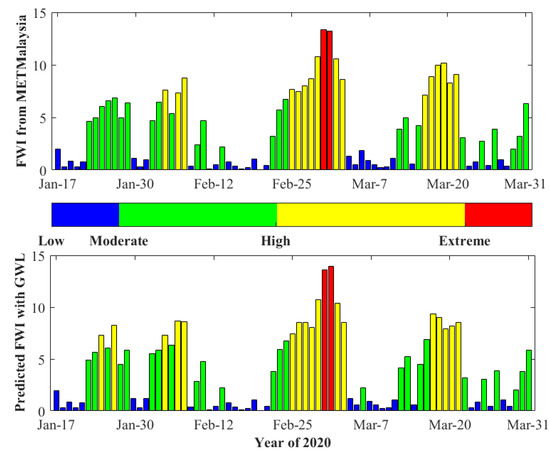
Figure 8.
Comparison of FWI predictions by nine-input, five-layer neural network with the data from METMalaysia.
The prediction of the Fire Weather Index (FWI) is a critical task for forest management and fire prevention. Furthermore, the predicted FWI values were compared to the FWI data published by METMalaysia for the period of 17 January to 31 March 2020. The comparison revealed a high degree of similarity between the predicted and actual FWI values, with the exception of a few discrepancies in the color-coded risk categories. Overall, this study demonstrates the effectiveness of using a neural network machine learning approach for predicting the FWI and its potential for supporting forest management and fire prevention efforts.
A forest fire has substantial harm, so it is of great significance to predict the occurrence of the forest fire. This paper takes the research object of the peatland forest in Raja Musa Forest Reserve (RMFR) in Selangor, Malaysia. It uses two different neural network structures, four inputs and nine inputs, to cooperate with the real-time data monitored by the IoT system and the actual Fire Weather Index published by the Malaysian meteorological department in the same period for machine learning and compares the predicted Fire Weather Index with the actual value, which helps to verify the reliability of the proposed neural network structure for peatland fire prediction.
The proposed method for predicting peatland forest fires in Malaysia demonstrates distinct advantages compared to the existing approaches [32,33]. It exhibits real-time capability and automation, setting it apart from traditional methods [34,35] reliant on manual data collection and analysis. By leveraging IoT technology, the method acquires real-time data on atmospheric temperature, humidity, wind speed, rainfall, groundwater level, solar radiation, air pressure, soil temperature, and soil humidity, thereby capturing the dynamic and rapidly changing environmental conditions that contribute to fire risk in peatland areas. Additionally, the utilization of machine learning algorithms facilitates the automatic processing and analysis of the collected data, enabling the efficient and timely prediction of the Fire Weather Index (FWI). The accuracy and reliability of the predictions are validated by comparing them with the actual values published by the Malaysian Meteorological Department during the corresponding period. This rigorous comparison reinforces the credibility of the method in accurately forecasting the FWI in peatland areas. Through the integration of real-time monitoring, automated analysis, and reliable validation, this method significantly enhances the accuracy and responsiveness of peatland forest fire prediction, thereby facilitating timely interventions and effective mitigation strategies.
4. Conclusions
The prediction of forest fires holds significant importance due to their devastating impact. This study focused on the peatland forest in the Raja Musa Forest Reserve (RMFR) in Selangor, Malaysia. By leveraging two different neural network structures, namely four inputs and nine inputs, in conjunction with real-time data collected by an IoT system and the actual Fire Weather Index from the Malaysian meteorological department, we developed machine learning models for peatland fire prediction. The reliability of the proposed neural network structures for peatland fire prediction was validated by comparing the predicted Fire Weather Index with the actual values.
The results demonstrate the favorable performance of both the four-input and nine-input structures, with the nine-input structure outperforming the four-input structure. Notably, employing a five-layer neural network yielded the best performance for both structures. The four-input structure achieved a mean square error of 1.537, mean absolute error of 0.975, root mean square error of 1.239, and correlation of 0.852. Similarly, the nine-input structure achieved a mean square error of 1.116, mean absolute error of 0.815, root mean square error of 1.056, and correlation of 0.890.
This finding has important guiding significance for the future fire prevention department to accurately evaluate the probability and risk of forest fires and formulate corresponding preventive measures. In the actual production and life process, it has a specific application value for careful supervision, effective fire prevention, and active risk resolution.
Author Contributions
Conceptualization, L.L., A.S. and A.I.; Methodology, L.L.; Software, L.L.; Validation, L.L., A.S., A.I. and F.H.; Formal analysis, L.L., N.K.N. and F.H.; Investigation, L.L.; Resources, L.L. and N.K.N.; Data curation, L.L., A.S. and A.I.; Writing—original draft, L.L. and A.S.; Writing—review & editing, L.L., A.S., N.K.N., A.I. and F.H.; Visualization, L.L.; Supervision, A.S., N.K.N., A.I. and F.H.; Project administration, A.S. and F.H.; Funding acquisition, A.S. All authors have read and agreed to the published version of the manuscript.
Funding
This work was supported by the National Institute of Information and Communications Technology (NICT) Japan, as well as Asia-Pacific Telecommunity (APT) with the projects NAPD: Networked ASEAN Peatland Data and Net-Peat: Networked ASEAN Peatland Communities for Transboundary Haze Alert under Grant UPM-NICT-APT 6380024-10801.
Data Availability Statement
Data available upon request.
Acknowledgments
The authors express sincere gratitude to the esteemed editor and the anonymous referees for their valuable insights and constructive feedback, which significantly enhanced the overall quality of this paper. The authors also acknowledge the Selangor State Forestry Department (JPNS) for granting permission to deploy the IoT system in RMFR, as well as the valuable collaboration and support from METMalaysia, Asia-Pacific Telecommunity (APT), SEARCA, Networked ASEAN Peatland Communities for Transboundary Haze Alert (NET-PEAT), Networked ASEAN Peatland Data (NAPD), LORANET Technologies, and Global Environment Centre (GEC). Their expertise, feedback, and assistance in validating the peatland data were instrumental in the successful completion of this research.
Conflicts of Interest
The authors declare that they have no known competing financial interests or personal relationships that could have appeared to influence the work reported in this paper.
References
- Smith, P.; Arneth, A.; Barnes, D.K.; Ichii, K.; Marquet, P.A.; Popp, A.; Pörtner, H.O.; Rogers, A.D.; Scholes, R.J.; Strassburg, B.; et al. How do we best synergize climate mitigation actions to co-benefit biodiversity? Glob. Chang. Biol. 2022, 28, 2555–2577. [Google Scholar] [CrossRef] [PubMed]
- Strack, M.; Davidson, S.J.; Hirano, T.; Dunn, C. The Potential of Peatlands as Nature-Based Climate Solutions. Curr. Clim. Chang. Rep. 2022, 8, 71–82. [Google Scholar] [CrossRef]
- Cochrane, M.A.; Page, S.; Hoscilo, A.; Langner, A.; Tansey, K.; Siegert, F.; Limin, S.; Rieley, J. Tropical peatland fires in Southeast Asia. In Tropical Fire Ecology: Climate Change, Land Use, and Ecosystem Dynamics; Springer: Berlin/Heidelberg, Germany, 2009; pp. 263–287. [Google Scholar] [CrossRef]
- Kiely, L.; Spracklen, D.V.; Arnold, S.R.; Papargyropoulou, E.; Conibear, L.; Wiedinmyer, C.; Knote, C.; Adrianto, H.A. Assessing costs of Indonesian fires and the benefits of restoring peatland. Nat. Commun. 2021, 12, 7044. [Google Scholar] [CrossRef] [PubMed]
- Li, W.; Li, P.; Feng, Z. Delineating Fire-Hazardous Areas and Fire-Induced Patterns Based on Visible Infrared Imaging Radiometer Suite (VIIRS) Active Fires in Northeast China. Remote Sens. 2022, 14, 5115. [Google Scholar] [CrossRef]
- Tedim, F.; Leone, V.; Amraoui, M.; Bouillon, C.; Coughlan, M.R.; Delogu, G.M.; Fernandes, P.M.; Ferreira, C.; McCaffrey, S.; McGee, T.K.; et al. Defining Extreme Wildfire Events: Difficulties, Challenges, and Impacts. Fire 2018, 1, 9. [Google Scholar] [CrossRef]
- Wiesner, B.J.; Dargusch, P. The Social License to Restore—Perspectives on Community Involvement in Indonesian Peatland Restoration. Land 2022, 11, 1038. [Google Scholar] [CrossRef]
- Vij, R. Types of Disasters. In Management of Animals in Disasters; Springer Nature Singapore: Singapore, 2022; pp. 3–14. [Google Scholar] [CrossRef]
- Bushnaq, O.M.; Chaaban, A.; Al-Naffouri, T.Y. The role of UAV-IoT networks in future wildfire detection. IEEE Internet Things J. 2021, 8, 16984–16999. [Google Scholar] [CrossRef]
- Hikouei, I.S.; Eshleman, K.N.; Saharjo, B.H.; Graham, L.L.; Applegate, G.; Cochrane, M.A. Using machine learning algorithms to predict groundwater levels in Indonesian tropical peatlands. Sci. Total Environ. 2023, 857, 159701. [Google Scholar] [CrossRef]
- Thompson, D.K.; Simpson, B.N.; Whitman, E.; Barber, Q.E.; Parisien, M.-A. Peatland Hydrological Dynamics as A Driver of Landscape Connectivity and Fire Activity in the Boreal Plain of Canada. Forests 2019, 10, 534. [Google Scholar] [CrossRef]
- Jefferson, U.; Carmenta, R.; Daeli, W.; Phelps, J. Characterising policy responses to complex socio-ecological problems: 60 fire management interventions in Indonesian peatlands. Glob. Environ. Chang. 2020, 60, 102027. [Google Scholar] [CrossRef]
- Kalajdjieski, J.; Zdravevski, E.; Corizzo, R.; Lameski, P.; Kalajdziski, S.; Pires, I.M.; Garcia, N.M.; Trajkovik, V. Air Pollution Prediction with Multi-Modal Data and Deep Neural Networks. Remote Sens. 2020, 12, 4142. [Google Scholar] [CrossRef]
- Lai, C.; Zeng, S.; Guo, W.; Liu, X.; Li, Y.; Liao, B. Forest Fire Prediction with Imbalanced Data Using a Deep Neural Network Method. Forests 2022, 13, 1129. [Google Scholar] [CrossRef]
- Zheng, X.; Chen, F.; Lou, L.; Cheng, P.; Huang, Y. Real-Time Detection of Full-Scale Forest Fire Smoke Based on Deep Convolution Neural Network. Remote Sens. 2022, 14, 536. [Google Scholar] [CrossRef]
- Chew, Y.J.; Ooi, S.Y.; Pang, Y.H.; Wong, K.-S. A Review of Forest Fire Combating Efforts, Challenges and Future Directions in Peninsular Malaysia, Sabah, and Sarawak. Forests 2022, 13, 1405. [Google Scholar] [CrossRef]
- Yaacob, N.S.; Ahmad, M.F.; Kawasaki, N.; Maniyam, M.N.; Abdullah, H.; Hashim, E.F.; Sjahrir, F.; Wan Mohd Zamri, W.M.I.; Komatsu, K.; Kuwahara, V.S. Kinetics Growth and Recovery of Valuable Nutrients from Selangor Peat Swamp and Pristine Forest Soils Using Different Extraction Methods as Potential Microalgae Growth Enhancers. Molecules 2021, 26, 653. [Google Scholar] [CrossRef]
- Yaacob, N.S.; Ahmad, M.F.; Sivam, A.; Hashim, E.F.; Maniyam, M.N.; Sjahrir, F.; Dzulkafli, N.F.; Wan Mohd Zamri, W.M.I.; Komatsu, K.; Kuwahara, V.S.; et al. The Effectiveness of Soil Extracts from Selangor Peat Swamp and Pristine Forest Soils on the Growth of Green Microalgae sp. Forests 2022, 13, 79. [Google Scholar] [CrossRef]
- Li, L.; Sali, A.; Liew, J.T.; Saleh, N.L.; Ahmad, S.M.S.; Ali, A.M.; Nuruddin, A.A.; Aziz, N.A.; Sitanggang, I.S.; Syaufina, L.; et al. Estimation of Ground Water Level (GWL) for Tropical Peatland Forest Using Machine Learning. IEEE Access 2022, 10, 126180–126187. [Google Scholar] [CrossRef]
- Sali, A.; Mohd Ali, A.; Ali, B.M.; Syed Ahmad Abdul Rahman, S.M.; Liew, J.T.; Saleh, N.L.; Nuruddin, A.A.; Mohd Razali, S.; Nsaif, I.G.; Ramli, N.; et al. Peatlands monitoring in Malaysia with IoT Systems: Preliminary experimental results. In Computational Intelligence in Information Systems: Proceedings of the Computational Intelligence in Information Systems Conference (CIIS 2020); Springer International Publishing: Berlin/Heidelberg, Germany, 2021; pp. 233–242. [Google Scholar] [CrossRef]
- Liew, J.T.; Sali, A.; Noordin, N.K.; Mohd Ali, B.; Hashim, F.; Mashohor, S.; Saleh, N.L.; Ouzrout, Y.; Sekhari, A. Sustainable peatland management with IoT and data analytics. In Proceedings of the Smart ansd Sustainable Collaborative Networks 4.0: 22nd IFIP WG 5.5 Working Conference on Virtual Enterprises, PRO-VE 2021, Saint-Étienne, France, 22–24 November 2021; Springer International Publishing: Berlin/Heidelberg, Germany, 2021; pp. 549–557. [Google Scholar] [CrossRef]
- Chen, Q.; Song, Y.; Zhao, J. Short-term traffic flow prediction based on improved wavelet neural network. Neural Comput. Appl. 2021, 33, 8181–8190. [Google Scholar] [CrossRef]
- Li, Z.; Chen, L.; Nie, L.; Yang, S.X. A novel learning model of driver fatigue features representation for steering wheel angle. IEEE Trans. Veh. Technol. 2021, 71, 269–281. [Google Scholar] [CrossRef]
- Ahmadi, M.; Soofiabadi, M.; Nikpour, M.; Naderi, H.; Abdullah, L.; Arandian, B. Developing a Deep Neural Network with Fuzzy Wavelets and Integrating an Inline PSO to Predict Energy Consumption Patterns in Urban Buildings. Mathematics 2022, 10, 1270. [Google Scholar] [CrossRef]
- Li, Z.; Liu, F.; Yang, W.; Peng, S.; Zhou, J. A survey of convolutional neural networks: Analysis, applications, and prospects. IEEE Trans. Neural Netw. Learn. Syst. 2021, 33, 6999–7019. [Google Scholar] [CrossRef]
- Kabir, H.D.; Abdar, M.; Khosravi, A.; Jalali, S.M.J.; Atiya, A.F.; Nahavandi, S.; Srinivasan, D. Spinalnet: Deep neural network with gradual input. IEEE Trans. Artif. Intell. 2022. [Google Scholar] [CrossRef]
- Van Wagner, C.E.; Petawawa, F. Development and Structure of the Canadian Forest Fireweather Index System. In Forestry Technical Report; Canadian Forestry Service: Victoria, BC, Canada, 1987; Volume 35, 35p, Available online: https://cfs.nrcan.gc.ca/publications?id=19927 (accessed on 5 February 2022).
- De Lima, R.S.; Li, K.-Y.; Vain, A.; Lang, M.; Bergamo, T.F.; Kokamägi, K.; Burnside, N.G.; Ward, R.D.; Sepp, K. The Potential of Optical UAS Data for Predicting Surface Soil Moisture in a Peatland across Time and Sites. Remote Sens. 2022, 14, 2334. [Google Scholar] [CrossRef]
- Rosa, S.L.; Kadir, E.A.; Syukur, A.; Irie, H.; Wandri, R.; Evizal, M.F. Fire Hotspots Mapping and Forecasting in Indonesia Using Deep Learning Algorithm. In Proceedings of the 3rd International Conference on Electrical Engineering and Informatics (ICon EEI), Virtual, 19–20 October 2022; pp. 190–194. [Google Scholar]
- Millard, K.; Darling, S.; Pelletier, N.; Schultz, S. Seasonally-decomposed Sentinel-1 backscatter time-series are useful indicators of peatland wildfire vulnerability. Remote Sens. Environ. 2022, 283, 13329. [Google Scholar] [CrossRef]
- Dyukarev, E.; Zarov, E.; Alekseychik, P.; Nijp, J.; Filippova, N.; Mammarella, I.; Filippov, I.; Bleuten, W.; Khoroshavin, V.; Ganasevich, G.; et al. The Multiscale Monitoring of Peatland Ecosystem Carbon Cycling in the Middle Taiga Zone of Western Siberia: The Mukhrino Bog Case Study. Land 2021, 10, 824. [Google Scholar] [CrossRef]
- Hayasaka, H.; Usup, A.; Naito, D. New Approach Evaluating Peatland Fires in Indonesian Factors. Remote Sens. 2020, 12, 2055. [Google Scholar] [CrossRef]
- Fitriany, A.A.; Flatau, P.J.; Khoirunurrofik, K.; Riama, N.F. Assessment on the Use of Meteorological and Social Media Information for Forest Fire Detection and Prediction in Riau, Indonesia. Sustainability 2021, 13, 11188. [Google Scholar] [CrossRef]
- Varela, V.; Vlachogiannis, D.; Sfetsos, A.; Karozis, S.; Politi, N.; Giroud, F. Projection of Forest Fire Danger due to Climate Change in the French Mediterranean Region. Sustainability 2019, 11, 4284. [Google Scholar] [CrossRef]
- Fernandes, P.M. Variation in the Canadian Fire Weather Index Thresholds for Increasingly Larger Fires in Portugal. Forests 2019, 10, 838. [Google Scholar] [CrossRef]
Disclaimer/Publisher’s Note: The statements, opinions and data contained in all publications are solely those of the individual author(s) and contributor(s) and not of MDPI and/or the editor(s). MDPI and/or the editor(s) disclaim responsibility for any injury to people or property resulting from any ideas, methods, instructions or products referred to in the content. |
© 2023 by the authors. Licensee MDPI, Basel, Switzerland. This article is an open access article distributed under the terms and conditions of the Creative Commons Attribution (CC BY) license (https://creativecommons.org/licenses/by/4.0/).